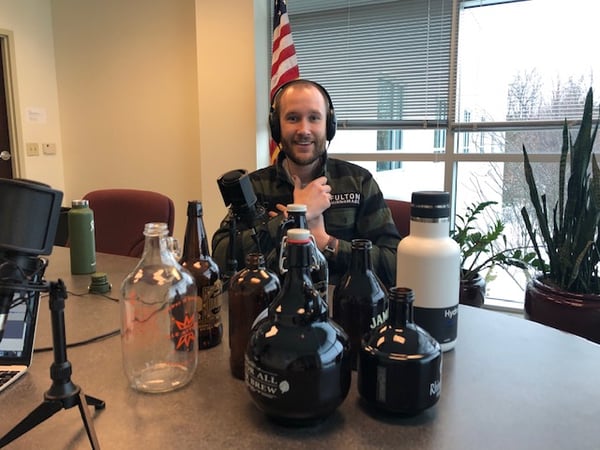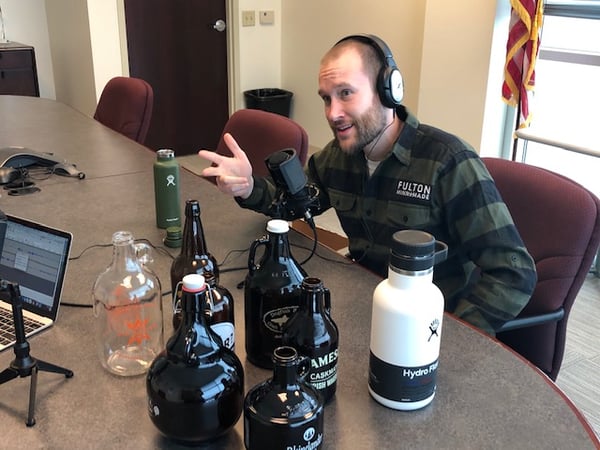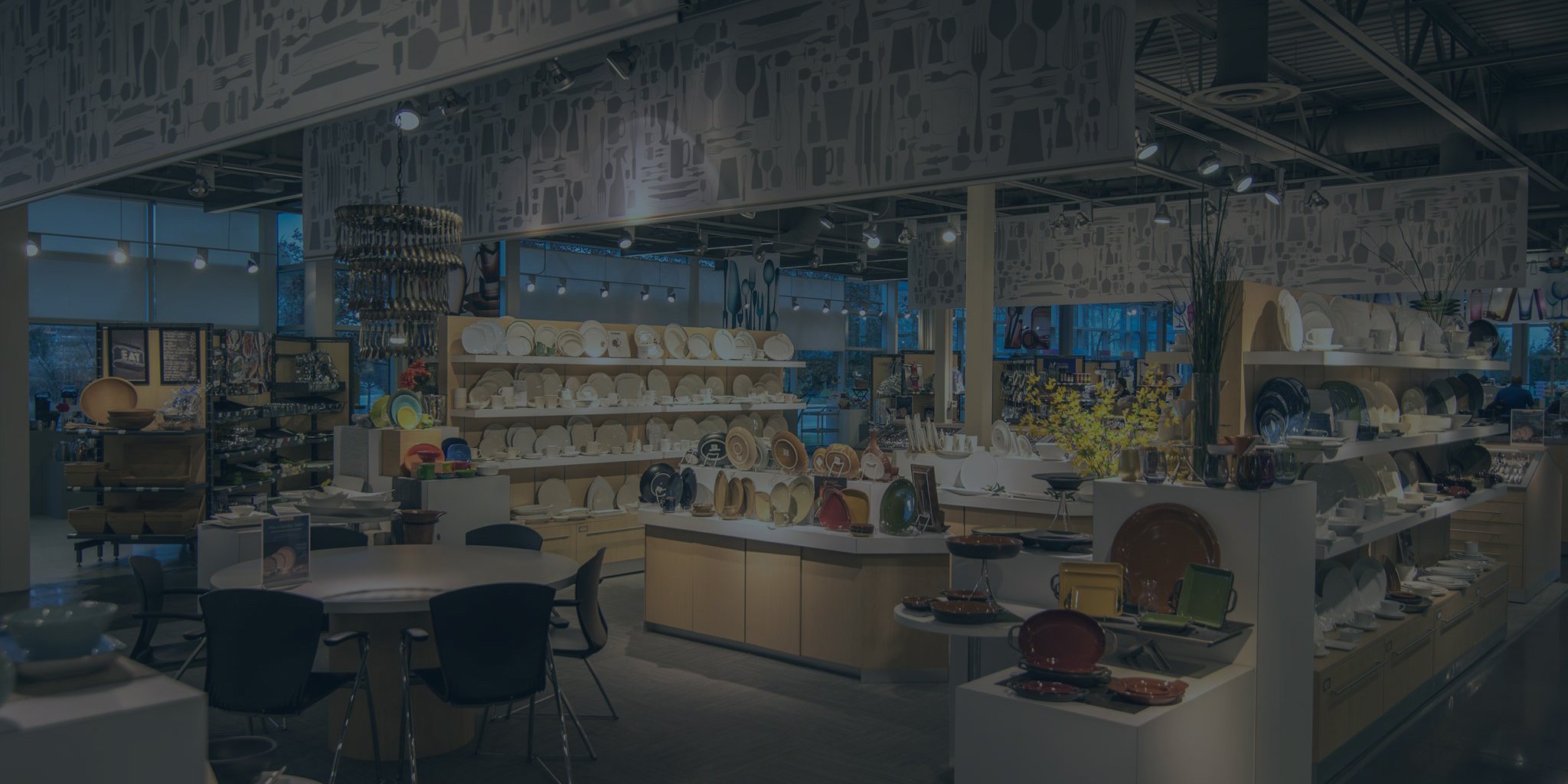Lance Taylor, Field Sales Manager of Boelter's beverage division, checks in with The Boelter Wire for a discussion about growlers–their origins, how their design has changed over the years and the creative efforts breweries are taking to incorporate their brand onto these steel, ceramic and glass containers.
Want to see what we can do for you and your brew? Get in touch. Or hear Lance chat about all things glassware in our previous episode: Right Beer, Right Glass.
Need to purchase some Growlers ? Check out our selection and order here: Growlers
Have a topic you'd like us to discuss? Send us your ideas at marketing@boelter.com!
Excerpts
Doing my research, I came across some fairly interesting historical facts... Did you know that growers had been around since the late 1800s? But more interestingly, they started out in a variety of containers: tin pails, pottery, glass jars, jugs. They used all these different containers to carry around their precious beer.
Lance Taylor: And sweet molasses. It's still the same. We'll get into that a little bit more, but there's a lot of different options that are still being used currently.
Did you know where the term growler–which is kind of an odd thing to call these things–where that term came from? I found out that the term growler was derived from the "growling" sound the beer would make when sloshing around these various containers. It's a combination of the carbon dioxide escaping from the lid.
Lance: That makes sense. It just goes to show, we're a little bit softer now than we were in the late 1800s. The term like growl really makes people thirsty back then. And now when you hear a little bit of carbon dioxide getting out of a container, a growler, it's more of a sweet whistle, like a dwarf or Snow White.
That's true. Another interesting fact, "bucket boys"–that was the nickname for the children. Now we're bringing the children into the mix. They were paid to fill empty buckets at local saloons and taverns and deliver them back to their owners. Now, I tell you, I've got three kids, teenagers. One of them is a little bit older than a teenager. I think I went wrong, raising them. I never even considered, "Hey, take this bucket to the local tavern. Fill it up for me, boy. Bring it back to me."
Lance: "Bring it back to me, boy." That sounds like you; that sounded comfortable and confident. "Do my bidding." That is interesting. What are these bucket boys? How do you warrant that? What's the uniform for a bucket boy?
I don't think there were uniforms. I don't think it was unionized. I don't think it was anything like that.
Lance: One thing to think about, too, back then is the refrigeration of all of this. I've watched a lot of old West movies and never really thought about what they're drinking. A lot of the times the beer wasn't even cold coming out of it. They did the best they could. I'm thinking like Arizona. They wouldn't even say "cold beer." They would promote "cool beer," maybe.
Take a guess in the earlier 20th century how much it cost to fill up a growler.
Lance: You hear the term "nickel beer." I'm guessing a nickel.
You are right on the money. Five to 15 cents to fill up a growler, and hence the term "nickel beer" was coined.
There were initially laws against serving alcohol on Sunday, and that led to the invention of something called the "duck." The duck is apparently a flask-like container with a lid and a hook, making it easier to hide the growler (a smaller grower, I would assume) under the arm of a coat.
Lance: And is this happening in church? All right. Whatever engages people.
I had not heard of the duck. It got me thinking a little bit how there's all these different shapes and sizes. Just get your mini growlers nowadays... I'm just imagining a flask with, with a bill. Like a duck.
And that whole Sunday thing with beer laws and liquor laws. It's still true today in some states. I know my travels take me to Minnesota often. Not until recently did they get a law passed for them to be able to purchase beer on Sundays.
That's fantastic. We've come a long way, obviously, since the birth of the grower. A lot of changes. Innovations, you might even say. Over the years, what have you been seeing with the grower? What’s new and interesting?
Lance: To start off, I think that breweries look at them as an opportunity to bring the tap room experience home a little. I mean, it doesn't get much more fresh than off the tap from the brewery from where the brew was created. So I think that's the exciting part about growlers.
There are a lot of different sizes and options. We have growlers here with us. We might have eight or nine different shapes and sizes here in front of us. All of them outside of a metal one. All the glass ones are an amber hue, except for one. I think people typically think of a 64-ounce is your standard size growlers. That's four pints full. So you can bring it back, and have it for a game of cards or something.
But there are a lot of sizes. It all depends. Again, some states have different funky law. To go back to Minnesota, just because I'm familiar with it, they can only sell 750-milliliter sizes, which is roughly 25 ounces. They can't sell any other sizes out of the tap room, which is kind of a fun, funky law for them to figure out. State by state, they're all different.
But 64 ounces is the most common. The 32 ounces came shortly after that. Probably inspired by the duck. Something to hide a little bit. Maybe you get a puffy coat, you sneak it in there.
So the ones that you brought in for us to kind of look at... It looks like the majority of them have screw tops. Looks like there's a couple that have a cork type. What difference is there? Is it just convenience? Does it keep one fresher over the other?
Lance: Not really. Growlers–since you're bringing it up–they're not necessarily the freshest option for beer. But, to get back to different styles, it's mainly to get customers interested. A lot of times, beer connoisseurs and consumers already have a growler or two. So some breweries like to get real adventurous with them, and there's a lot of different European styles and shapes that are available out there. Beyond that, you can decorate them to make them very interesting looking as well.

I noticed there's different shapes that we're looking at here. The majority of them seem fairly similar, but we've got this one here that looks like a genie bottle. That one's pretty cool. Some of them have little handles, I guess for easier carrying. Others just look like a regular bottle.
Lance: Yeah. This goes back to when they didn't have anything officially termed as a growler and people were just making whatever they wanted to be a growler. So some of these shapes kind of imitate that. The traditional growler shape was actually originally designed for maple syrup, and they still are used for maple syrup. However, the growler for beer is really primary use nowadays.
And along with that, that's not considered always, is the pressure that they can withstand. They're not all pressurized. In fact, the best way to go for a pressurized bottle is going with the stainless steel option. That's going to be the safest one. Instead of about $4 to $5, you're looking at maybe $60, if you get a name brand one. $30. There is a major difference.
Is there a typical type of beer that these craft brewers are putting in the growlers, or does it cover the spectrum, anything can go into it?
Lance: It depends on the brewery, but typically not a super high ABV is going to go in a 64-ounce growler. The cost is going to be very high. So typically, they try to avoid that or save that for a bomber bottle, which is a similar concept to a growler. With the bomber bottle, though, it's typically pre-packaged, pre-filled and is some sort of a special release. It's already ready to go. People can just buy it off the shelf.
With growlers, some breweries will fill them on the spot as they're ordered. But a lot of breweries, to preserve the freshness, have growler fillers, which is a machine that does it automatically. They just have them pre-filled, ready to go, to be purchased. The reason for that is because when you do it without the growler filling station, and you put the hose right on the faucet to the draft line, oxygen can get in there, and it's not going to stay fresh as long.
That was going to be one of my follow up questions. Anything, as soon as you open it, the carbonation decreases almost immediately. How long does one of these larger, even a smaller growler, how long does the beer that's in it stay fresh? Are these designed to be one sitting, you want to finish that thing off and then take it back and fill it up? Or could you crack it and pour yourself a glass, close it back up, put it back and put it in your fridge–keep it cold for a couple of days, a week?
Lance: If you have a can of beer and you open it up, are you going to put it back in the fridge after you sip on it? Twenty-four hours is recommended. That's kind of the rule of thumb.
But really if you ask a brewer, that's why they don't like the growlers very much. It's just because it doesn't preserve the freshness. And a lot of the times, if somebody's filling up a growler and bringing it to, say, a holiday party, that could be the first touch point, first experience with that brewery for a family member or whoever you're sharing it with. Breweries don't necessarily always like the idea of growlers, just because it doesn't necessarily always represent the quality of their product.
What's interesting with growlers is, with breweries that are smaller and startups, they really rely heavily on growler sales, and they use them often. That's just because they don't really have the means to can their beer, to bottle their beer. It's easier for them to just put it out of a keg and a growler. Often, they rely very heavily on that. But as brewers get bigger and they start canning or bottling, that’s much fresher.
The growler experience is fun and cool just because it's something different than just popping a can, but the can is definitely going to be your freshest option. It's not forcing you to drink 64 ounces of liquid in one sitting. Because really, once you open it, ideally you don't want to close it and open it back up.
That makes sense. Now, some of the bottles you brought here are darker colored. There is the one here that's clear. Differences, benefits, pros, cons? Does it matter?
Lance: It does matter. If you look at beer bottles for the most part, too, they all have a hue to them. Amber's most popular here in the States, and that's because light pollution, when UV light hits beer manipulates the composition of the liquid itself. It's some sort of acid, and there's some nice chemistry behind the scene. Some brewer's rolling his eyes about this right now.
Maybe. I guess the way I'm looking at it is, these craft brewers, they've got so many different brews that they put out each year and they're so special to them. The coloration of some of these beers is pretty important too, right? When they're pouring it out the glass at the tap room. I would almost think that having a clear bottle shows off that special new recipe more than a darker bottle.
Lance: You're absolutely right. That's why I think people turn to the clear, just because you can see it, and that adds to that experience for sure. But in reality, UV light can really make the beer skunky. It takes about 40 minutes of UV light only to really change the flavor of beer. So that's why you want to have color.
And that's why, again, those stainless steel are really the premium option. That's the one that you want, if you can afford it, and if you can get your hands on it, for multiple reasons. It's going to keep the beer fresher longer. It's going to keep it colder for sure, and that light pollution factor doesn't become much of a problem.
As a result, growlers are turning into what is called a crowler machine. It's a play on the word "growler" and "can." It's essentially a can that is filled either on the spot or filled pre-purchase and ready to go. Very similar to the growler, but it's just a big can.
It’s 32 ounces, the standard. But for Minnesota, where they have that law for the 750-milliliter, they have that size. You're starting to see 16-ounce tall boy cans being filled right at the brewery now as well. That's something that you can keep fresher longer. You don't have to consume it pretty much immediately after getting it filled.
It's an investment on the brewery's part. That's for sure. But they're finding it. That's becoming a lot more popular. A lot of these breweries are doing crowlers, and then maybe a premium 64-ounce stainless. Maybe a 32-ounce stainless as well. But that's the trend that we're starting to see with growlers.
 For these crowlers, are they made out of the typical aluminum can. or is it a different material?
For these crowlers, are they made out of the typical aluminum can. or is it a different material?
Lance: It is aluminum can. The technology was actually created by Oskar Blues, based out of Longmont, Colorado.
Are those more of a "one and done" than the glass growlers? One of my questions, at least with the glass growler, is being able to reuse it. Once it's empty, one of the benefits is that you can take it back to that brewer, and they'll fill it up for you. Are you just cleaning these things with soap and water, and then you take it back? Can you do the same thing with one of these crowlers that we're talking about?
Lance: You can't. If you're looking at a crowler, to you it's just going to look like a huge can. Really, the way that it works is they're filled, and then the can, the tool that you use to fill it, and then what you use to cap it off, too... That right there... If you don't see that process, it's just going look like any kind of can. You pop the top. It's just like a can; pull it off, that's open. One and done. Crowlers are always one and done.
...
Let's talk about some of the decorating capabilities for the craft brewers. This seems like a good opportunity if you're an established brewer. If you're just getting off the ground and starting, it seems like a good opportunity to have your logo, the name of your brewery on the side of these things, and now it's out in the world. Like you mentioned, a growler could be make a good holiday gift, where you're just bringing it to a party and you're sharing. It's like free advertising essentially. What kind of things have you seen in the market recently that's been popping up? New and interesting?
Lance: Sure. To be decorated legally, they need to at least have the name of the brewery and the address for most states, for sure in Wisconsin here. So they know where it came from. They also have to have the government warning on there. That's on all cans and all beverages with alcohol.
Typically they’re decorated. It's very, very rare that you see when undecorated. The cost is minimal to have them decorated. More often than not, since growlers are a bigger item, they're a little bit pricier than most standard purchases a brewery makes for drinkware. But kind of a requirement or an expectation when people go into a brewery.
More often than not, they're just one color and that's fine. You see a lot of white on the dark amber growler. You can definitely do whatever color you want. With Boelter, if we're going to decorate it for you, it's going to be the same price, whether it's white, black or whatever color you can come up with.
The one thing with growlers is they're not the easiest thing to decorate all the time. As far as doing a full wrap on them, you can do a nice wrap, but that handle gets in the way of our decorating machines. It's kind of a challenge to do that, but pretty much put any design on there. You have a huge imprint space on there, so you can do some pretty cool things with the art.
What about, is that a Hydro Flask? What about the option of engraving? Is that something that is a possibility?
Lance: Definitely. That's kind of the best look for it. They're powder coated, the Hydro Flask. When you powder coat it, you get to see that actual stainless color that pops through. It looks real sharp.
Engraving is actually pretty much the same price as if you're going to just print it, if you're going to have screen printed. Screen printing has a bigger print area. With engraving, you can't really do a wrap of engravement. But you can with screen printed. You can do multiple colors as well. So they both have their advantages.
A lot of the times people like to choose engraving after. That's the assumption, engraving is more expensive. It's not always. It's for sure permanent as well. Screen printing, it's not going to go anywhere. And it's not like you're throwing, a Hydro Flask in the dishwasher necessarily. You're definitely not supposed to.
...
So, when you're out and about, and you're meeting with all your different customers, do growlers come up often? Or is this something that... I mean, we talked about the history of growers. It's been around for a long time. Obviously the design, the decorations have changed and been innovated over the last several years. I think growlers were very popular at one point. Are you seeing that popularity trending downward or trending away from the glass and going more towards the crowlers? Is this idea of a growler at all, is that trending away?
Lance: I don't think it's ever going to go away. It's part of the expectation for consumers. People like to have that experience at home. It's the fresh tap room experience taste that you can bring there. The only thing that's kind of false about that perception is if they bring it home and they sit on it for, you know, a week or two…
Then it's too late. It's not worth it.
Lance: However, it still is fun to whip that out and share it with everybody. It's definitely more special than just, "Here's a can" and "I brought a six pack."
But as far as growlers go and the popularity and the trend, what we're starting to see, it totally depends on the size of the brewery. If it's a smaller brewery, like I said before, they're going to lean heavily on growler sales, especially out of the gate. Because that's the easiest way to get beer in the consumer's hands outside of the tap room.
They look great behind the bar as well. A lot of the times, you'll see a bunch of growlers stacked up with their logo on it, and it looks great.
In reality, a lot of people are turned off by purchasing a whole 64-ounce bottle of beer, and they like the idea of a smaller quantity. So, you're starting to see that the 32 ounces are either growler or crowler sales. Those are getting a little bit more popular. It is good to have options. Is it going to be a big night or a little night?
Want to chat with a Boelter expert? Get in touch!

The Boelter Wire is an episodic podcast that focuses on thought-leadership conversations with industry experts and established partners, and is designed to help listeners evolve their business, stay competitive and pursue their passions.
Subscribe to The Boelter Wire here or on Spotify, Google Play, Apple Podcasts or Amazon Music.
.jpg?width=192&name=BLT_Only_Logo_Black%20(19).jpg)





